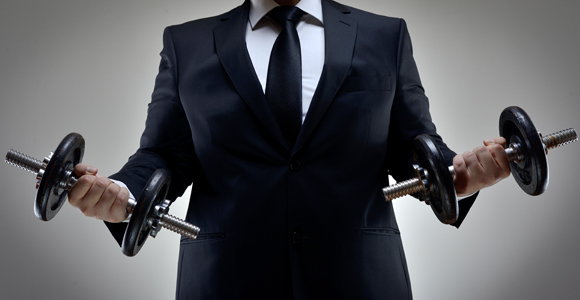Have you heard about the new bike-sharing programs in several big cities in the U.S.? Avoid the hassles of traffic and occasional road-rage and hop on a city bike instead. Not only will you save time on your commute if you live in a bustling city, you'll also save the money you usually spend on gas, a taxi, the bus, or the train.
But the benefits don't stop there. Bonus: biking is great exercise! Research has found the people who bike to get from point A to point B gain fewer pounds than their car-driving counterparts. But wait...there's more! Biking can tone your gams, get your heart pumping, tighten your core and give you an energy jolt, so much so that in one study participants saw a 65 percent reduction in fatigue. Forgo that morning coffee run and jump on your bike to get to work instead. You'll feel naturally energized throughout your day.
Commuting to and from work on a bike is a great way to add some exercise into your workday, but we understand that this isn't a practical approach for everyone. So we've put together eight more simple, easy ways to sneak in exercise:
- If you work in a facility that has multiple floors, take the stairs instead of the elevator.
- Keep a couple of dumbbells or kettle balls at your workplace (if you work in an office you can keep them underneath your desk). Take a 10 to 15 minute break to do some strength training.
- Use your lunchbreak as a time to squeeze in a little physical activity. Spend half of your typical lunchbreak going for a walk around the workplace or around the neighborhood. You'll not only reap the physical benefits of exercise (improved cardiovascular fitness, increased muscle toning, enhanced flexibility), you'll also experience mental benefits as well. You'll be more focused and less stressed, enabling you to tackle the second half of your day.
- If you take a bus to work or to run errands, get off one stop before your usual drop-off. You can add an additional 10 to 15 minutes of walking each day, and that extra exercise adds up over the course of a week.
- Do some calisthenics each day. Calisthenics are exercises that use your own body weight--think lunges, push-ups, tricep dips, squats, heel raises, leg lifts and crunches. Most calisthenic exercises can be done anywhere and don't require a fancy gym membership or special equipment, although you could amp up the intensity by holding weights or attaching weighted arm or leg bands while you perform them.
- When waiting in line at the grocery store or the bank, flex and engage your muscles while you stand there. Flex your abs, your thighs, your calves, or any muscle group you want to tone. These little tricks will help you maintain strong muscles and also help prevent boredom.
- Park far away from your destination. I'm sure you've heard this tip before, but it really does work. If you're shopping or running errands, park in the space furthest from the building, or park several blocks away and walk to your destination.
- If you work an office job, skip the impersonal emails and phone calls and walk to your coworkers' offices or cubicles instead. You'll probably get a lot more accomplished with in-person discussions, and throughout the day you'll be walking more, burning more calories than you would hitting "send email" from your desk.
6 Ways to Make Exercise a Habit
Kari Hartel, RD, LD is a Registered, Licensed Dietitian and freelance writer based out of St. Louis, MO. Kari is passionate about nutrition education and the prevention of chronic disease through a healthy diet and active lifestyle. Kari holds a Bachelor of Science in Dietetics from Southeast Missouri State University and is committed to helping people lead healthy lives. She completed a yearlong dietetic internship at OSF St. Francis Medical Center in Peoria, IL, where she worked with a multitude of clients and patients with complicated diagnoses. She planned, marketed, and implemented nutrition education programs and cooking demonstrations for the general public as well as for special populations, including patients with cancer, heart disease, diabetes, Alzheimer's disease, obesity, and school-aged children.




